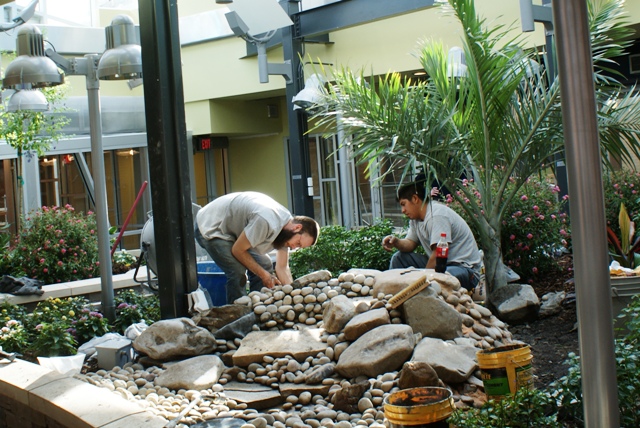
Dark for several years because of a much-needed $27 million renovation, Center in the Square will spring back to life in May when it reopens to the public. More room for tenants, a more spacious atrium featuring large fish tanks and a rooftop café are all in the mix. The Church Avenue building, also owned and connected to the main Center facility on Campbell, has already been remodeled; the Waldron Stage has already started staging plays.
One of the more noteworthy additions to the “new” Center in the Square, located inside the revamped Science Museum of Western Virginia, will be the 2800 sq. ft tropical butterfly garden, which at any one time will feature dozens of species, along with native plants from regions around the world where those species would exist.
The butterfly garden will be entered through a special set of doors on the 4th floor; the Science Museum will also occupy the 5th floor as it spreads out. The garden will be warm and humid – just like a tropical paradise. Expect 70-80% humidity and temperatures in the mid 80’s.
Visitors, who will pay a separate charge aside from the museum admission for the butterfly garden, will be inspected inside an airlock room once they leave the exhibit – just to make sure they haven’t picked up any hitchhiking butterflies. There’s also a danger that some of those butterflies could introduce a rare disease in the Roanoke area, perhaps affecting local plants, one big reason visitors must be inspected by attendants after they leave the butterfly atrium. Butterflies also like to crawl inside purses and backpacks, which must also be inspected.
Lead animal care specialist Derek Kellogg was recruited from a museum in Rochester, New York to oversee the butterfly garden. The Kansas native studied entomology in college, so he knows a thing or two about insects. He earned a master’s at the University of Kansas but was more interested in dinosaurs, reptiles and birds as a youngster.
Kellogg said he, “kind of worked my way through [to insects],” after he ran out of things to discover about other species. There are more than a million species of insects, according to Kellogg, the total number of mammal species (maybe four to five thousand), and all other animal species together add up to only about 60,000.
There is all sorts of insect knowledge at Kellogg’s disposal. Ants, for example, use waste disposal systems and set up their nests for more efficient airflow; they also wage war and practice slavery, “all of these things that we typically associate with human society,” said Kellogg.
There are between 100,000 and 120,000 known species of butterflies and moths, more than any other classification of insects, according to Kellogg. He noted that the tropical atmosphere inside the glass-enclosed butterfly garden (great views of downtown are a bonus) means plants will grow rapidly in many cases. That entails constant trimming and picking up dead flower petals.
“You can’t run a butterfly exhibit without taking care of your plants,” said Kellogg recently, as workers toiled over the garden landscape. Some plants will flower every day. It’s “pretty balmy in here,” notes Kellogg.
The Science Museum will not breed butterflies and Kellogg said they would avoid the plants that encourage mating by giving off familiar scents that trigger the reproductive process. The museum will hold permits allowing it to display as many as 100-200 species. The species on display at the Science Museum exhibit, which opens to the general public along with Center in the Square on May 18, will rotate depending on availability from suppliers.
The National Museum of Play, Kellogg’s former home, featured a smaller butterfly facility and a living coral reef. But the weather is better in Roanoke and was more to his wife’s liking, he joked. “[She’s] not a big fan of snow [either],” he also noted. The opportunity to work at an actual science museum also attracted Kellogg, who likes the partnership with Virginia Tech; “It’s extremely attractive to me.”
“It’s really exciting to see everything coming together. It’s a lot of fun to be part of shaping something that is new,” said Kellogg of the renovated Science Museum, which will reopen with brand new galleries and a rotating exhibit hall. The attractions include Healthy Bodies, Healthy Earth, How it Works, the Butterfly exhibit, a Touch Tank and Living River exhibits.
Kellogg will focus on butterflies and the other small animals on the premises: “Most of the interaction that people have with insects are negative – this is a great way to experience …better ways of understanding insects.” (see smwv.org for more information. The museum is also recruiting a volunteer staff.)
By Gene Marrano


